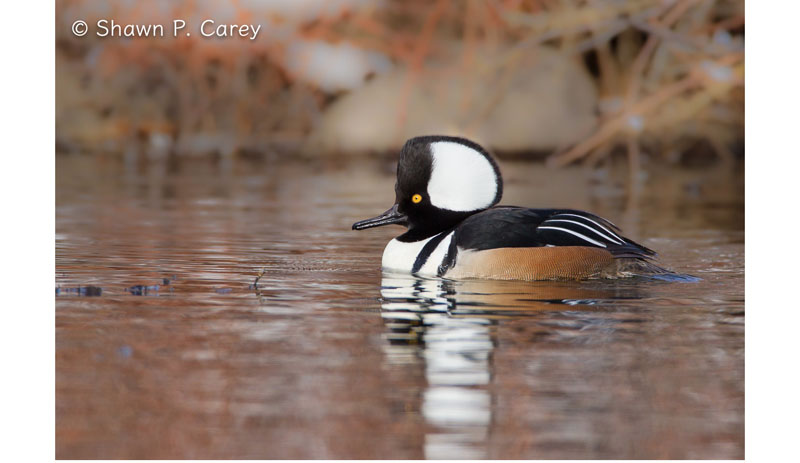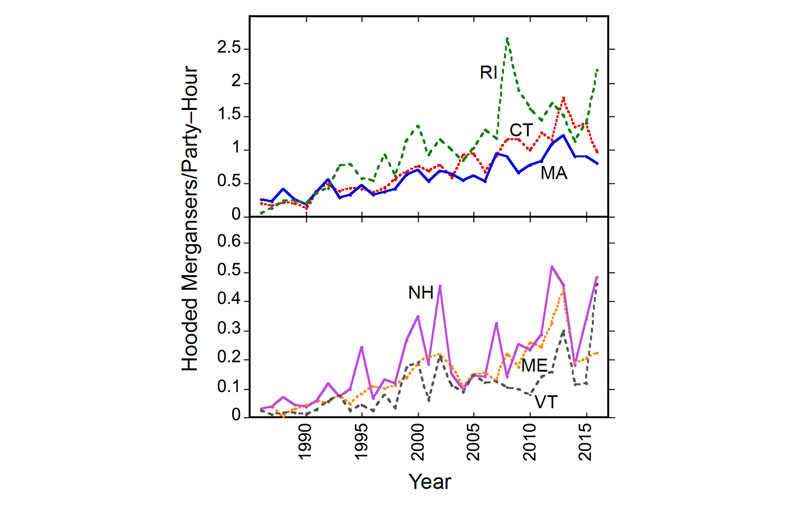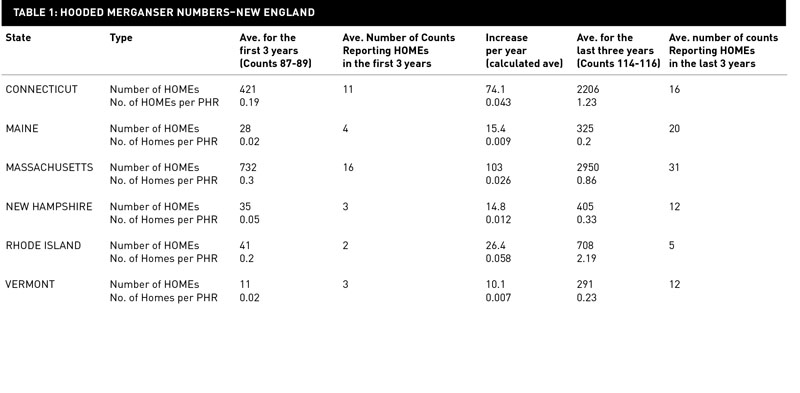Steve Davis

Hooded Merganser. Photograph © Shawn P. Carey.
In my experience, Hooded Mergansers (Lophodytes cucullatus) are much easier to find in southern New England than they were 30 years ago. A quick look at the National Audubon Society’s Christmas Bird Count (CBC) numbers supported this observation, so I decided to do a more comprehensive analysis of the New England CBC Hooded Merganser data from the last 30 years to see if the quick look and the personal feeling were supported by the data. I found that the data indeed show that the numbers of Hooded Mergansers have increased in all six New England states. I also did a detailed analysis of the Hooded Merganser data from Massachusetts to obtain a more comprehensive view of this increase.
In a prior article in this journal (Davis 2000), I discussed the status of Hooded Mergansers in New England as reported in the CBCs for the late 1980s and late 1990s. That article, which demonstrated significant increases during that decade, serves as a baseline for this analysis. This article documents the continuing increase in reported Hooded Mergansers in all six New England states. As the numbers and graphs below show, each state has had a roughly linear increase in numbers through the past thirty years, although the rates of increase have been different for each state.
Data on Hooded Merganser counts from the six New England states for the years 1986 to 2015 (CBC numbers 87 to 116) were provided by the National Audubon Society. They also provided measures of effort by count; that is, the number of driving and walking party-hours and hours at feeders. These data are also available on their website.

Figure 1. Upper panel. Hooded Mergansers per party-hour for Connecticut (CT, dotted line), Massachusetts (MA, solid line), and Rhode Island (RI, dashed line). Lower panel. Hooded Mergansers per party-hour for Maine (ME, dotted line), New Hampshire (NH, solid line), and Vermont (VT, dashed line). Note different scales on y-axes.
For the first part of this analysis for the six New England states, I considered both the number of Hooded Mergansers per count circle each year from 1986 to 2015 and the number of Hooded Mergansers per party-hour per count circle. For the second part of this analysis, which looks in more detail at the counts for Massachusetts, I also considered the number of count circles reporting Hooded Mergansers and the total number of count circles each year.
More Hooded Mergansers are being counted, but are there really more Hooded Mergansers in New England? Although there are increases in reported Hooded Mergansers, there are many reasons why the number of birds identified could increase without there being an increase in the actual population of the species. During the past thirty years, there has been an increase in the number of count circles in each state. Consequently, there has been an increase in the number of party-hours and party-miles, two of the effort factors. There has also been an increase in the percentage of counts that have reported Hooded Mergansers. The analysis of the Massachusetts data in the second part of this article addresses some of these issues.
Part 1: The New England States

Table 1. Comparative Values for the Six New England States
I analyzed the numbers of Hooded Mergansers and the number of Hooded Mergansers per party-hour from each state with Statistix7 (Analytical Software, Tallahassee FL) and Microsoft Excel. As discussed below, the resulting graphs and statistical data are striking in that there have been increases in both categories in each New England state for the past 30 years. In general, the values contain yearly variations but seem to be generally increasing.
I also calculated average values for the number of Hooded Mergansers and of Hooded Mergansers per party-hour for the first three years and for the last three years of the 30 year period. The average yearly increases in these values for each state were derived from linear regressions done on the data. Also, I graphed the values for the thirty years for each state. Figure 1 shows the values of the number of Hooded Mergansers per party-hour for the six states.
The results of the numerical analyses for each of the New England states are shown in Table 1. In all of the states, the average number of Hooded Mergansers for the last three years of CBC counts (2013, 2014, and 2015) increased from the average number for the first three years (1986, 1987, and 1988), as did the average number of count circles reporting Hoodeds over the same three-year periods. The number of Hooded Mergansers identified per party-hour increased as well. Over 30 years, the average yearly increase in the number of Hooded Mergansers identified varied state by state. Connecticut saw an annual average increase of 74.1 Hoodeds, Maine averaged 15.4, Massachusetts 103, New Hampshire 14.8, Rhode Island 26.4, and Vermont 10.1
Part 2: Massachusetts

Figure 2. Total number of Hooded Mergansers in Massachusetts reported by Christmas Bird Counts.
Although the increases in reported Hooded Mergansers for each state are statistically significant as demonstrated by the linear regression analysis, as mentioned above, there are many reasons why the number of birds reported could increase without there being an increase in the actual population of the species. First, there have been increases in the number of CBCs conducted in each state. In the first three years of this analysis, Massachusetts averaged 16 counts per year; in the last three years, the average was 31, almost twice as many. There have also been increases in the number of party-hours and party-miles. Even with increases in the number of count circles, the percentage of counts that have reported Hooded Mergansers has increased, suggesting that Hooded Mergansers have expanded their winter locations. In the first three years of this analysis about 60% of the count circles in Massachusetts reported Hooded Mergansers; for the last five years, the average has been about 97%, with about one count circle per year not reporting Hoodeds.
Jim Berry published a thoughtful discussion of these issues a while back in this journal (Berry 1992). As Berry wrote, the increased number of species reported in CBCs was likely due to:
…better birders using better optics and better field guides. There can be little question that species totals would have increased significantly over the years for these reasons even if all other factors had been constant.
Today, his list might also include more birders in more circles using internet-communicated locations. Berry and others, however, have determined that the number of birds of a species recorded per party-hour is the most reliable measure for comparative analyses over time.
Although the effects of the above factors on the apparent increases in the numbers of Hooded Mergansers identified cannot be definitively assessed, a comparison of the numbers of Hooded Mergansers and the number per party-hour is informative. When the graph of the actual number of Hooded Mergansers counted in Massachusetts through the years (Figure 2) is compared with the number of Hooded Mergansers per party-Hour through the years for Massachusetts (upper panel, Figure 1), the visual impression is that there is a close correlation. The calculated correlation coefficient is actually 0.98. The correlation coefficients of these two recording methods for the other five New England states are: Connecticut 0.98; Maine 0.97; New Hampshire 0.98; Rhode Island 0.93; and Vermont 0.97. Because the correlation coefficients are so close to 1.00 for New England Hooded Merganser counts, then, the trends for the total numbers reported and the numbers per party-hour are essentially interchangeable. Using the per party-hour correction, however, probably makes for a more accurate representation of the slopes of the increases since it takes into consideration increased numbers of counts and increased total effort.
In summary, this analysis of the number of Hooded Mergansers identified on New England Christmas Bird Counts for the past 30 years demonstrates increases for each state. Each of the six states has shown an increase through the years both in the number of Hooded Mergansers found and in the number of Hooded Mergansers found per party-hour. The average increase in the number of birds per year has ranged from 10.1 birds per year for Vermont to 103 birds per year for Massachusetts. Although there are factors that influence the number of Hooded Mergansers identified, the party-hour calculation helps to standardize the trends.
Why have the reported numbers of wintering Hooded Mergansers been increasing in our region? Similar to the CBCs, the Breeding Bird Survey has documented an increasing number of Hooded Mergansers, including in New England, over the past several decades (Sauer et al. 2017). While the underlying reasons for this increase are unknown, possibilities include the increased amount of beaver-created breeding habitat, increased open water during the CBCs consequent to warming winter temperatures, as well as the increased coverage and skill of counters. It will be interesting to see what the numbers of Hooded Mergansers in New England do over the next 30 years.
References
- Berry, J. 1992. A Selective Analysis of Data From the Newburyport Christmas Bird Count. Bird Observer 20: 314-322.
- Davis, S. 2000. The Change in Numbers of Wintering Hooded Mergansers (Lophodytes cucullatus) in New England. Bird Observer 28: 164-168.
- Sauer, J. R., D. K. Niven, J. E. Hines, D. J. Ziolkowski, Jr, K. L. Pardieck, J. E. Fallon, and W. A. Link. 2017. The North American Breeding Bird Survey, Results and Analysis 1966 - 2015. Version 2.07.2017 USGS Patuxent Wildlife Research Center Laurel, MD. Accessed June 5, 2017.
Steve Davis is a retired family doctor who has birded extensively in Swansea. He thanks Kathy Dale and Geoff LeBaron of the National Audubon Society for providing the CBC data, and Cody and Cameron Bernier of Swansea, MA for help with data extraction.